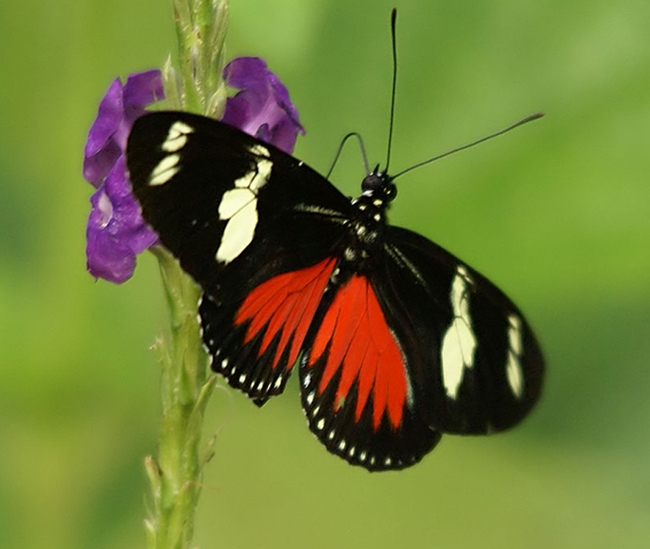
Heliconius butterflies will take center stage, so to speak, when James Mallet of Harvard University presents a lecture at the University of California, Davis on Wednesday, Nov. 28.
Mallet will discuss “Hybridization, Mimicry and the Origin of Species in Heliconius Butterflies” from 12:10 to 1 p.m. in Room 1022 of the Life Sciences Addition (LSA). The talk, open to all interested persons, is part of the UC Davis Department of Entomology’s fall seminar series.
The adults’ brightly colored wing patterns signal their distastefulness to potential predators.
“It is a seductive idea that species are independent evolutionary units,” says Mallet, whose research focuses on the evolution and genetics of Amazonian butterflies. “Natural hybridization is rare in nature on a per-individual basis, but it may affect many species. Brightly colored Heliconius butterflies engage in Müllerian mimicry of other species. Although most of this mimicry is due to adaptive reconstruction of similar patterns, we've long suspected that color patterns are exchanged among some closely related species that hybridize occasionally in nature.”
Müllerian mimicry, named after German naturalist Fritz Müller, occurs when two or more poisonous species, “that may or may not be closely related and share one or more common predators, have come to mimic each other’s warning signals” (Wikipedia).
“We have recently shown that genomic regions that determine mimicry have been exchanged repeatedly among species to form new, adaptive combinations,” Mallet says. “Through their joint effects on mating behavior and signaling to predators, these novel color patterns are also involved in triggering evolution of new species.”
Heliconius, a widespread genus, is distributed throughout the tropical and subtropical regions of the New World, from South America to the southern United States. The larvae eat passion flower vines (Passifloraceae).
Before accepting a position as a distinguished lecturer earlier this year at Harvard's Department of Organismic and Evolutionary Biology, Mallet was a professor of biodiversity at University College London (UCL) from 1992 to 2012. He describes himself as an avid natural historian and a Darwin enthusiast. He has led courses in tropical ecology in southern Europe, Africa and across South America.
Mallet served as a Helen Putnam Fellow at Harvard's Radcliffe Institute for Advanced Study from 2009 to 2010. Among his many appointments, Mallet is an honorary research fellow at the Natural History Museum, London, and a research associate at the Smithsonian Tropical Research Institute, Balboa, Panama.
Mallet received his bachelor’s degree in zoology in 1976 from Oxford University; his master’s degree in applied entomology from the University of Newcastle-upon-Tyne in 1978; and his doctorate in zoology at the University of Texas, Austin in 1984. He was a NERC Fellow (Natural Environment Research Council Fellowship) in genetics and biometry from 1985 to 1988 at UCL before joining Mississippi State University's Department of Entomology as an assistant professor.
Mallet will be introduced by medical entomologist/professor Greg Lanzaro of the UC Davis School of Veterinary Medicine.
Plans call for Mallet's lecture to be videotaped and then posted at a later date on UCTV.
Attached Images:
